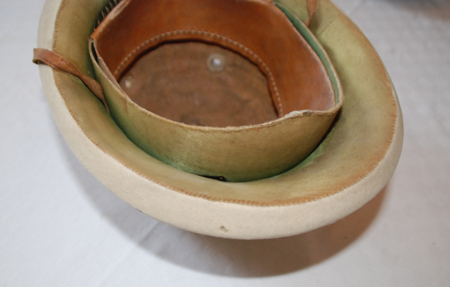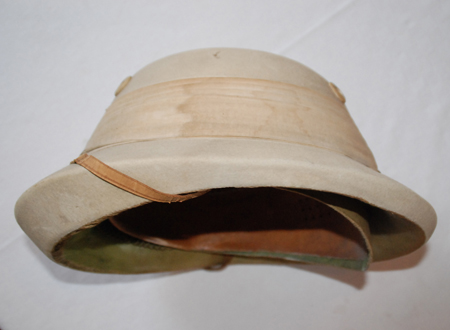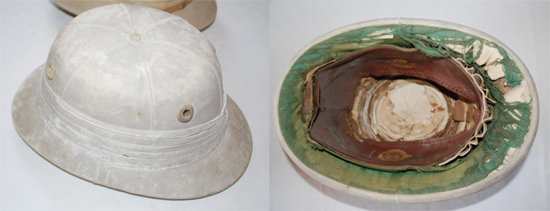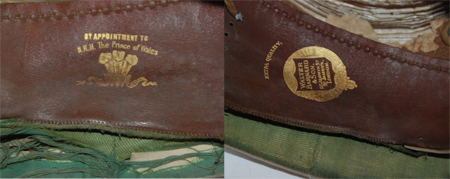In 1899, London hat maker Walter Barnard of Jermyn Street, St. James’s, patented a fashionable helmet with a metal grill between sweatband and hat to allow ventilation. Here is an example of this helmet and later a variation whose ventilation strip was produced in rubber.
The interior of this helmet, otherwise made from pith, does not use silk, but a thin layer of cork to cover the interior above the hatband. The cork is stamped with “Patent No. 21,119 of 1899. Extra Quality” Underneath that is Barnard´s logo.
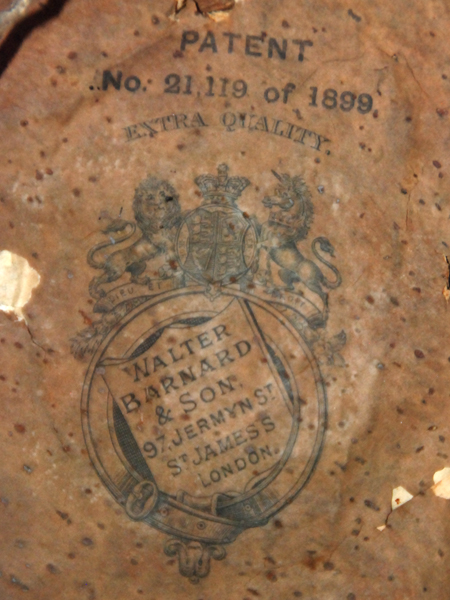
No label – the producer´s information is directly printed on the cork interior. (Author’s collection)
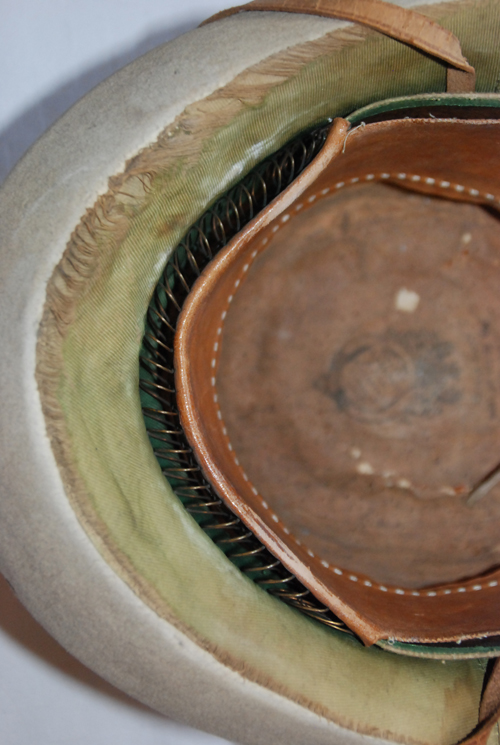
The metal grill for ventilation is clearly shown to the front of the interior. (Author’s collection)
The headband is much broader at the back and altered, indeed it extends passed the brim. This part is made from cardboard, covered on i
ts outside with the same silk as the lower side of the brim. Opposite the wearer’s forehead is a metal grill. This is the only ventilation of the interior beside four holes formed by rubber grommets. Is this the feature that was patented? A new and better form of ventilation?
The broad headband, constructed to keep the helmet tightly on the head and the large rubber grommets, typical for polo helmets, seem to indicate, that this construction was either intended for polo or riding or but sports in general. On the other side, the fashionable felt coverage and green silk lining could fit plain clothes as well. Maybe, the newly patented hat was hoped to sell to a broader range of customers than sportsman. Though at that time, about 1899, someone using a horse, being a common form of transport before automobiles appeared, would not have called himself a sportsman but maybe he wished for a more stylish dress as well?
For as well being stylish, but uncommon, and therefore remarkable is the thick front part of the brim, which is in fact twice as thick as the back brim. It gives the helmet a kind of aerodynamic appearance, but it is unclear, if this has – as part of the “patent” – any effect, for example, on the temperature inside. Only fashion?
The second example, made from pith but covered with canvas, has a far more sports like appearance. Again we have the bright silk lining underneath and the hatband extended with cardboard (though collapsed here), but the thick brim has disappeared and the metal grill was replaced by rubber pieces, constructed like a cartridge belt. The interior is partly gone, we do not know if the patent was mentioned inside, but there is a Barnard logo on the middle of the leather hatband and opposite another gilt stamp.
A Barnard helmet of similar construction is attributed to be a South African police helmet on an internet website, but it remains unclear if it was issued or a private purchase of that very officer. Source: http://www.militaryheadgear.com/items/12845 ).
Whatever Barnard´s intention, maybe to bring up a product more competitive to match other, far more successful pith helmet producers, at least we do have another extravagant construction. It does not appear anywhere else. The reason might have been patent protection or, more likely, it simply was not successful.
Finally, a remark about the history of collecting pith helmets – for the benefit of the reader who grew up with the internet where auction platforms serve scarce things on a silver tray every day, leaving the collector with only two problems; to make his choice and to remind himself of his own financial abilities – at least from time to time.
Of course there have always been flea markets and antique fairs. But another source for pith helmets in the 80s and 90s were shop windows. Whenever safari clothes turned up as a fashion theme for the summer, fancy dress plastic imitations of pith helmets – but vintage helmets as well – were likely to appear. My highlight in this respect was a department store just opposite the town hall of Neuss, near Düsseldorf in Germany, which, in the early 80s, was decorated with not less than four (!!) dark green Afrika Korps felt helmets at one time. Unfortunately, I did not think then of taking a picture of this. Political correctness was not then in the peoples’ minds as it is today. These helmets still had their shields (insignia) on, but so turned against the wall, that the side with the eagle was not clearly visible. Today even the black/white/red shield in a German shop window would cause any company a lot of trouble.
My trouble was that in all the many cases of a shop window appearance, none of the people responsible – whether employees or freelance – ever sold me a single helmet. The usual, but understandable excuse with chain stores was that the helmets were signed for and had to be returned to some central depot of decoration goods. Freelance decorators always stated that they would not sell theirs, because they were over happy to have one and could never get a replacement. “Have you ever tried to get hold of a pith helmet?” I knew exactly what they meant.
Now, the felt Barnard turned up in 1999 – in an optician´s shop window near Munich, decorating sun-glasses. “Customers ask for pith helmets quite regularly – they like it.” So again, it was not for sale – never! – but it could be bartered for two Italian world war two helmets which were then being sold in surplus stores for 29 D-Mark (about 15 Euro today) in any number required. The canvas Barnard turned up two months later in a Munich flea market – probably the same owner? We will never know – pith helmets keep their secrets.
Another secret is the appearance of large numbers of German and Italian helmets, size 56, in the 80s and 90s. But – this is another story.
Roland Gruschka


